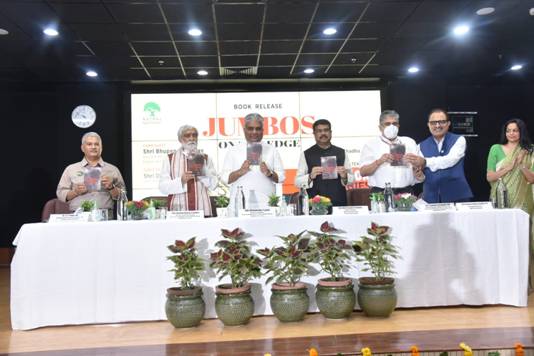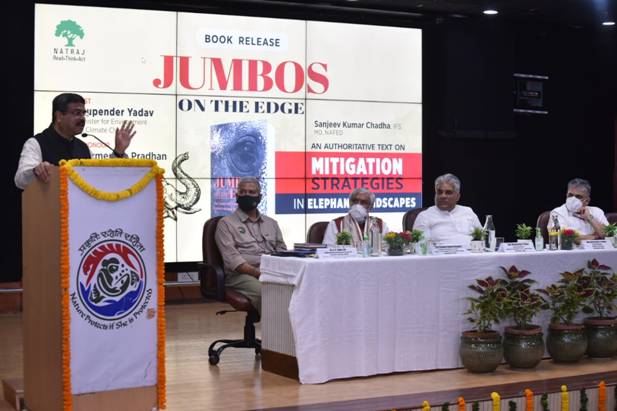
- Self-Study Guided Program o Notes o Tests o Videos o Action Plan

Minister for Environment, Forest and Climate Change, Shri Bhupender Yadav today said that the focus of the government under the leadership of Prime Minister, Shri Narendra Modi is not just increasing the tree and forest cover in the Country quantitatively but more importantly qualitatively.
Shri Yadav was speaking at the launch of “Jumbos on the Edge: The Future of Elephant Conservation in India” a book by Shri Sanjeev Kumar Chadha, an Indian Forest Service officer currently serving as Managing Director of National Agricultural Cooperative Marketing Federation of India Ltd.(NAFED). Shri Dharmendra Pradhan, Union Minister for Education, Skill Development and Entrepreneurship also graced the occasion.

Speaking on the Human-Elephant conflict and the measures taken by the Project Elephant division with Elephant range states, Shri Yadav emphasized on people’s awareness and participation as a crucial step in managing and conserving both flora and fauna of the country while ensuring life and livelihood.
Elephant is our national heritage. Happy to share that the @moefcc recently initiated the verification exercise of elephant corridors and is also working on mapping land use and land cover of elephant reserves in the country using GIS technology which will also aid conservation.
“Environment Ministry is not an obstacle but a solution provider” , said Shri Yadav while elaborating on the role played by Ministry of Environment as an enabler of sustainable growth and development and congratulated the author who having spent a lifetime in the forests across India has brought those learning’s and research together in the form of an book.
Minister for Education and Skill development, Shri Dharmendra Pradhan recollecting incidences of human elephant conflict from his native state of Odisha stated that the case studies the suggestions brought forward in the book will help all stakeholders involved to incorporate in their existing and future implementation for a more holistic approach to development.

Indian Elephant (Elephasmaximus) is a keystone species andan integral component of ecosystems playing a crucial role in maintaining forest ecosystem and biodiversity. It has been recognized as National Heritage Animal of India and highest degree of protection has given under Indian Wildlife Protection Act (1972). India has the largest population of Asian Elephants with 30000 wild and about 3600 captive elephants.
Human-elephant conflict is a major conservation concern in elephant range states in India and emerged as one of the most challenging problems for elephant management and conservation in recent times. Human-Elephant Conflict (HEC) refers to the negative interaction between people and elephants, leading to a negative impact on people or their resources such as human death and injury, crop damage, loss of property, apart from affecting their emotional well-being, and on the elephants or their habitats.
The Ministry has taken several steps to address the issues. Some of the major ones are:
***
GK
Minister for Environment, Forest and Climate Change, Shri Bhupender Yadav today said that the focus of the government under the leadership of Prime Minister, Shri Narendra Modi is not just increasing the tree and forest cover in the Country quantitatively but more importantly qualitatively.
Shri Yadav was speaking at the launch of “Jumbos on the Edge: The Future of Elephant Conservation in India” a book by Shri Sanjeev Kumar Chadha, an Indian Forest Service officer currently serving as Managing Director of National Agricultural Cooperative Marketing Federation of India Ltd.(NAFED). Shri Dharmendra Pradhan, Union Minister for Education, Skill Development and Entrepreneurship also graced the occasion.

Speaking on the Human-Elephant conflict and the measures taken by the Project Elephant division with Elephant range states, Shri Yadav emphasized on people’s awareness and participation as a crucial step in managing and conserving both flora and fauna of the country while ensuring life and livelihood.
Elephant is our national heritage. Happy to share that the @moefcc recently initiated the verification exercise of elephant corridors and is also working on mapping land use and land cover of elephant reserves in the country using GIS technology which will also aid conservation.
“Environment Ministry is not an obstacle but a solution provider” , said Shri Yadav while elaborating on the role played by Ministry of Environment as an enabler of sustainable growth and development and congratulated the author who having spent a lifetime in the forests across India has brought those learning’s and research together in the form of an book.
Minister for Education and Skill development, Shri Dharmendra Pradhan recollecting incidences of human elephant conflict from his native state of Odisha stated that the case studies the suggestions brought forward in the book will help all stakeholders involved to incorporate in their existing and future implementation for a more holistic approach to development.

Indian Elephant (Elephasmaximus) is a keystone species andan integral component of ecosystems playing a crucial role in maintaining forest ecosystem and biodiversity. It has been recognized as National Heritage Animal of India and highest degree of protection has given under Indian Wildlife Protection Act (1972). India has the largest population of Asian Elephants with 30000 wild and about 3600 captive elephants.
Human-elephant conflict is a major conservation concern in elephant range states in India and emerged as one of the most challenging problems for elephant management and conservation in recent times. Human-Elephant Conflict (HEC) refers to the negative interaction between people and elephants, leading to a negative impact on people or their resources such as human death and injury, crop damage, loss of property, apart from affecting their emotional well-being, and on the elephants or their habitats.
The Ministry has taken several steps to address the issues. Some of the major ones are:
***
GK